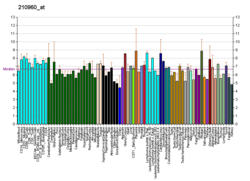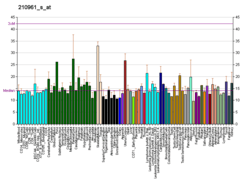Alpha-1D adrenergic receptor
The alpha-1D adrenergic receptor (α1D adrenoreceptor), also known as ADRA1D, is an alpha-1 adrenergic receptor, and also denotes the human gene encoding it.[3]
Receptor
There are 3 alpha-1 adrenergic receptor subtypes: alpha-1A, -1B and -1D, all of which signal through the Gq/11 family of G-proteins and different subtypes show different patterns of activation. They activate mitogenic responses and regulate growth and proliferation of many cells.
Gene
This gene encodes alpha-1D-adrenergic receptor. Similar to alpha-1B-adrenergic receptor gene, this gene comprises 2 exons and a single intron that interrupts the coding region.[3]
Ligands
- Antagonists
See also
References
- ↑ "Human PubMed Reference:".
- ↑ "Mouse PubMed Reference:".
- 1 2 "Entrez Gene: ADRA1D adrenergic, alpha-1D-, receptor".
- ↑ Buckner SA, Milicic I, Daza A, Lynch JJ, Kolasa T, Nakane M, Sullivan JP, Brioni JD (2001). "A-315456: a selective alpha(1D)-adrenoceptor antagonist with minimal dopamine D(2) and 5-HT(1A) receptor affinity". Eur. J. Pharmacol. 433 (1): 123–7. PMID 11755142. doi:10.1016/s0014-2999(01)01519-9.
- ↑ Cleary L, Murad K, Bexis S, Docherty JR (2005). "The alpha (1D)-adrenoceptor antagonist BMY 7378 is also an alpha (2C)-adrenoceptor antagonist". Auton Autacoid Pharmacol. 25 (4): 135–41. PMID 16176444. doi:10.1111/j.1474-8673.2005.00342.x.
External links
- Human ADRA1A genome location and ADRA1A gene details page in the UCSC Genome Browser.
- Human ADRA1D genome location and ADRA1D gene details page in the UCSC Genome Browser.
Further reading
- Schwinn DA, Lomasney JW (1992). "Pharmacologic characterization of cloned alpha 1-adrenoceptor subtypes: selective antagonists suggest the existence of a fourth subtype.". Eur. J. Pharmacol. 227 (4): 433–6. PMID 1359975. doi:10.1016/0922-4106(92)90162-O.
- Bruno JF, Whittaker J, Song JF, Berelowitz M (1991). "Molecular cloning and sequencing of a cDNA encoding a human alpha 1A adrenergic receptor.". Biochem. Biophys. Res. Commun. 179 (3): 1485–90. PMID 1656955. doi:10.1016/0006-291X(91)91740-4.
- Esbenshade TA, Hirasawa A, Tsujimoto G, et al. (1995). "Cloning of the human alpha 1d-adrenergic receptor and inducible expression of three human subtypes in SK-N-MC cells.". Mol. Pharmacol. 47 (5): 977–85. PMID 7746284.
- Schwinn DA, Johnston GI, Page SO, et al. (1995). "Cloning and pharmacological characterization of human alpha-1 adrenergic receptors: sequence corrections and direct comparison with other species homologues.". J. Pharmacol. Exp. Ther. 272 (1): 134–42. PMID 7815325.
- Weinberg DH, Trivedi P, Tan CP, et al. (1994). "Cloning, expression and characterization of human alpha adrenergic receptors alpha 1a, alpha 1b and alpha 1c.". Biochem. Biophys. Res. Commun. 201 (3): 1296–304. PMID 8024574. doi:10.1006/bbrc.1994.1845.
- Loftus SK, Shiang R, Warrington JA, et al. (1994). "Genes encoding adrenergic receptors are not clustered on the long arm of human chromosome 5.". Cytogenet. Cell Genet. 67 (2): 69–74. PMID 8039425. doi:10.1159/000133802.
- Yang-Feng TL, Han H, Lomasney JW, Caron MG (1994). "Localization of the cDNA for an alpha 1-adrenergic receptor subtype (ADRA1D) to chromosome band 20p13.". Cytogenet. Cell Genet. 66 (3): 170–1. PMID 8125015. doi:10.1159/000133693.
- Forray C, Bard JA, Wetzel JM, et al. (1994). "The alpha 1-adrenergic receptor that mediates smooth muscle contraction in human prostate has the pharmacological properties of the cloned human alpha 1c subtype.". Mol. Pharmacol. 45 (4): 703–8. PMID 8183249.
- Minneman KP, Lee D, Zhong H, et al. (2000). "Transcriptional responses to growth factor and G protein-coupled receptors in PC12 cells: comparison of alpha(1)-adrenergic receptor subtypes.". J. Neurochem. 74 (6): 2392–400. PMID 10820200. doi:10.1046/j.1471-4159.2000.0742392.x.
- Keffel S, Alexandrov A, Goepel M, Michel MC (2000). "alpha(1)-adrenoceptor subtypes differentially couple to growth promotion and inhibition in Chinese hamster ovary cells.". Biochem. Biophys. Res. Commun. 272 (3): 906–11. PMID 10860850. doi:10.1006/bbrc.2000.2850.
- Kyprianou N, Benning CM (2000). "Suppression of human prostate cancer cell growth by alpha1-adrenoceptor antagonists doxazosin and terazosin via induction of apoptosis.". Cancer Res. 60 (16): 4550–5. PMID 10969806.
- Deloukas P, Matthews LH, Ashurst J, et al. (2002). "The DNA sequence and comparative analysis of human chromosome 20.". Nature. 414 (6866): 865–71. PMID 11780052. doi:10.1038/414865a.
- Shibata K, Katsuma S, Koshimizu T, et al. (2003). "alpha 1-Adrenergic receptor subtypes differentially control the cell cycle of transfected CHO cells through a cAMP-dependent mechanism involving p27Kip1.". J. Biol. Chem. 278 (1): 672–8. PMID 12409310. doi:10.1074/jbc.M201375200.
- Pupo AS, Minneman KP (2004). "Specific interactions between gC1qR and alpha1-adrenoceptor subtypes.". J. Recept. Signal Transduct. Res. 23 (2–3): 185–95. PMID 14626446. doi:10.1081/RRS-120025200.
- Hague C, Uberti MA, Chen Z, et al. (2004). "Cell surface expression of alpha1D-adrenergic receptors is controlled by heterodimerization with alpha1B-adrenergic receptors". J. Biol. Chem. 279 (15): 15541–9. PMID 14736874. doi:10.1074/jbc.M314014200.
- Gonzalez-Cabrera PJ, Shi T, Yun J, et al. (2004). "Differential regulation of the cell cycle by alpha1-adrenergic receptor subtypes". Endocrinology. 145 (11): 5157–67. PMID 15297446. doi:10.1210/en.2004-0728.
- Zhang T, Xu Q, Chen FR, et al. (2005). "Yeast two-hybrid screening for proteins that interact with alpha1-adrenergic receptors". Acta Pharmacol. Sin. 25 (11): 1471–8. PMID 15525470.
- Sigala S, Dellabella M, Milanese G, et al. (2005). "Evidence for the presence of alpha1 adrenoceptor subtypes in the human ureter". Neurourol. Urodyn. 24 (2): 142–8. PMID 15690361. doi:10.1002/nau.20097.
- Chen Z, Hague C, Hall RA, Minneman KP (2006). "Syntrophins regulate alpha1D-adrenergic receptors through a PDZ domain-mediated interaction". J. Biol. Chem. 281 (18): 12414–20. PMID 16533813. doi:10.1074/jbc.M508651200.
- Michelotti GA, Brinkley DM, Morris DP, et al. (2007). "Epigenetic regulation of human α1d-adrenergic receptor gene expression: a role for DNA methylation in Sp1-dependent regulation". FASEB J. 21 (9): 1979–93. PMC 2279228
 . PMID 17384146. doi:10.1096/fj.06-7118com.
. PMID 17384146. doi:10.1096/fj.06-7118com.
This article is issued from
Wikipedia.
The text is licensed under Creative Commons - Attribution - Sharealike.
Additional terms may apply for the media files.

